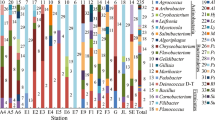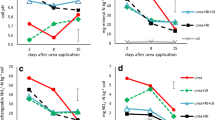Summary
Bacteria which can hydrolyse urea are common in soils. Of six soils examined, some 17–30 per cent of the total bacterial populations, including aerobes, micro-aerophiles and anaerobes, could hydrolyse urea. One of the soils had been enriched with urea for at least ten years, yet the proportion of ureolytic bacteria (24 per cent) was similar to that of normal soils.
Addition of urea to a red-yellow podzolic soil low in available carbon and under different moisture conditions did not increase the total urease activity, the size of the bacterial population or the ratio of ureolytic to non-ureolytic bacteria. However, when available carbon as glucose was added with urea to this soil, urease activity and size of the bacterial population both increased, but the ratio of ureolytic to non-ureolytic bacteria in the population remained unchanged.
Similar content being viewed by others
References
Broadbent, F. E., Hill, G. N., and Tyler, K. B., Transformations and movement of urea in soils. Soil Sci. Soc. Am. Proc. 22, 303–307 (1958).
Bunt, J. S., and Rovira, A. D., Microbiological studies of some subantarctic soils. J. Soil Sci. 6, 119–128 (1955).
Clark, F. E., Agar-plate method for total microbial count. In Method of soil analysis, ed. C. A. Black. Agronomy 9, 1460–1466 (1965).
Hoffmann, G. and Teicher, K., Colorimetric determination of urease activity in soils. Z. Pflanzenernähr. Düng. Bodenk. 95, 55–63 (1961).
Paulson, K. N. and Kurtz, L. T., Locus of urease activity in soil. Soil Sci. Soc. Am. Proc. 33, 897–901 (1969).
Pick, L. A. and Allison, F. E., Adsorption and release of urease by and from clay minerals. Soil Sci. 91, 183–188 (1969).
Pinck, L. A., Dyal, R. S., and Allison, F. E., Proteinmontmorillonite complexes, their preparations and the effects of soil micro-organisms on their decomposition. Soil Sci. 78, 109–118 (1954).
Roberge, M. R., Effects of toluene on microflora and hydrolysis of urea in a black spruce humus. Canad. J. Microbiol. 14, 999–1003 (1968).
Roberge, M. R. and Knowles, R., The ureolytic microflora in a black spruce (Picea mariana Mill.) humus. Soil Sci. Soc. Am. Proc. 31, 76–79 (1967).
Seneca, H., Peer, P., and Nally, R., Microbial urease. Nature 193, 1106–1107 (1962).
Skujins, J. J., Enzymes in soil. In Soil Biochemistry, eds. A. D. McLaren and G. H. Peterson. Marcel Dekker, Inc., New York (1967).
Sumner, J. B. and Somers, G. F., Chemistry and Methods of Enzymes, 3rd ed. Academic Press, New York (1953).
Volk, G. M., Volatile loss of ammonia following surface application of urea to turf or hare soils. Agron. J. 51, 746–749 (1959).
Volk, G. M., Gaseous loss of ammonia from surface-applied nitrogenous fertilizers. J. Agr. Food Chem. 9, 280–283 (1961).
Author information
Authors and Affiliations
Rights and permissions
About this article
Cite this article
Lloyd, A.B., Sheaffe, M.J. Urease activity in soils. Plant Soil 39, 71–80 (1973). https://doi.org/10.1007/BF00018046
Received:
Issue Date:
DOI: https://doi.org/10.1007/BF00018046




